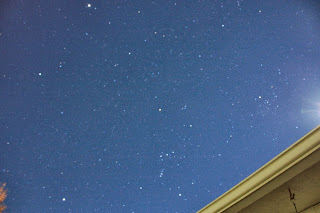Date Time: October 21, 2013 0500-0600 hrs and 1130-1240 hrs
Weather: Clear, cool 5 degrees Celsius, no wind to light breeze at 0600 hrs. Warm, breezy, 15 degrees Celsius, 15 mph winds, high wispy clouds, mostly sunny at 1200 hrs
Equipment: 8" Meade LX200, Canon DSLR solar filter attached to telescope for solar imaging and observing.
Attendance: Myself
Objective: To observe and image Comet ISON which is in Leo, near Mars.
Report: The main focus on this morning was to view and image Comet ISON. After observing with the telescope and a 32 mm eyepiece, and taking many time exposure images of the area around Mars, a confirmed sighting could not be made. It was surprising that the comet didn't stand out in the images, because there have been many reported sightings and many images posted on the internet. Sites like Astronomy.com and Spaceweather.com are posting lots of images of comet ISON by amateur astronomers as well as many confirmed sightings through binoculars and telescopes.
This comet is suppose to go very close to the sun around the end of November, so it will brighten in the near future. This observer will be watching, hopefully the weather will cooperate!
Jupiter was viewed through the telescope. Only 3 moons were observed and there were stars visible in the background, which is rare in this observers experience.
Two shooting stars in the SE were observed. One coming straight down, the other coming from the direction of Orion. Both were very fast with the Orionid quite bright.
Around noon, the solar filter was attached and the Sun was observed. Many sunspots were seen including the Sunspot groups 1877 and 1875 and sunspot 1872. For a neat video of the Sun at this time go to this webpage.
Sunspot group 1875 looked like a small dipper which was very interesting. Its amazing how many star formations look like a dipper. Examples are the Big Dipper (Ursa Major), Small dipper (Ursa Minor), M45 and M42 all have formations that look like a dipper. Seeings how sunspots could be affected somehow by gravity, there could be some general gravitational affect that causes bodies to form like this. It could also be a coincidence.
It must be noted how we are getting lots of nice observing weather, which has been exceedingly rare for this area over the last year at least.
 |
| M45 image taken on October 14, 2013 with just camera and 300 mm lens |
 |
| Mars looking for Comet ISON time elapse 6 second |
 |
| Jupiter |
 |
| Jupiter 1/8 second elapsed time image. This is done to bring out the cloud lines. |
 |
| Jupiter at 4 second exposure |
 |
| M42 at 4 second time exposure |
 |
| M42 at 30 second time exposure |
 |
| Sirius, Orion, and Taurus in the SW at dawn. |
 |
| Jupiter, almost straight up to the SE at dawn. |
 |
| Mars in Leo, looking east at dawn. |
 |
| Sun 1/8 second time exposure 12 |
 |
| Sunspot groups 1877 and 1875 and sunspot 1872 |

No comments:
Post a Comment